Wild turkey is my all-time favorite game meat. It’s easy to cook, it has plenty of rich flavor, and it’s just about impossible to beat fried turkey nuggets dipped in spicy barbecue sauce. Talk to any serious turkey hunter, and they’ll agree. However, not all turkey hunters know how to butcher a turkey and get every cut of meat.
In the video below, my turkey hunting buddy Josh Dahlke does a really nice job demonstrating the basic butchering process on a wild turkey. With most of the birds I shoot, I follow the exact same process Dahlke uses here.
But sometimes, I want more than just the breasts and legs. Some turkeys are killed on hunts that are more meaningful, and I want to savor every bite as a way of making that hunt last just a little longer. Here are the main cuts and organs you can harvest when you butcher a turkey:
The breasts and legs (meaning drumsticks and thighs) are the most popular cuts and you can see how to remove them in the video above. Wild turkey wings are often overlooked, mostly because they are a hassle to pluck and clean. But if you go through the trouble of harvesting turkey wings, you’ll be rewarded with surprisingly meaty cuts that can be served up in a killer buffalo wing recipe. The giblets consist of the gizzard, heart, and liver. Heart and gizzard meat are pretty similar (rich and a little chewy, in a good way) when fried and dunked in hot sauce. The liver, of course, has more of an iron taste.
Everyone takes the breast meat from their turkeys. But not everybody gets all the breast meat they should. The key to leaving no meat on the bone is to use an ultra-sharp, flexible blade. You don’t want to use your thick deer hunting knife for this job. The breastbone has curves and angles that you need to work the blade around. It’s more like filleting a fish than quartering a deer. (Read our review of the best hunting knives, here.)
Also, the breast meat on a turkey goes up much higher on what I’d call the shoulder of the bird. Make sure you peel back the skin all the way up to the wing to ensure you don’t miss any of that golden meat. After you’ve pulled each breast from your bird, it’s time to think about how o freeze each hunk of meat. On a big tom, I like to cut each breast in half so that I’ve got four dinners worth of turkey breast meat. The top of the breast is thicker and has an almost roast-like consistency. I’ll slice the breast in half so that I’ve got one thick, condensed cut and then a wider, thinner cut.
Turkey is a traditional centerpiece of many Thanksgiving meals. Instead of buying a frozen bird from the grocery store you may want to raise and harvest your own turkey for a farm-to-table holiday dinner. Harvesting your own turkey can save money and allows you to know exactly how the bird was raised and processed. Here is a step-by-step guide on how to humanely harvest a turkey for your Thanksgiving feast.
Selecting and Raising Your Turkey
There are many different breeds of turkeys to choose from. The Broad Breasted White is the most common commercial variety. It matures quickly and produces a large breast meat yield. Heritage breeds like Bourbon Red, Narragansett, and Standard Bronze take longer to mature but have more flavorful meat.
Turkeys can be raised on pasture or kept confined in a pen. Pastured birds will have more muscle and rich, flavorful meat. Provide a coop or shelter for roosting and keep them safe from predators. Feed starter or grower feed until 12-14 weeks of age then switch to a finish or maintenance ration. Make sure they have access to fresh water at all times.
Preparing for Harvest
Plan to harvest your turkey 1-2 days before you will cook it You will need a killing cone or shackles, large pot for scalding, knives, clean tables or counters, and a clean space for processing. Have plastic bags, shrink wrap, or freezer paper ready to store the packaged meat
The day before harvest, move turkeys to a clean pen and remove any food but leave water. This emptying of the crops and intestines will make cleaning easier.
Sharpen your knives and assemble any other necessary tools. Clean all surfaces that will contact the meat. Have a bowl or pot of cold clean water ready to submerge your knives in between steps.
Killing and Bleeding Out
There are a few options for humane slaughter. Stunning with a sharp blow to the head can render them unconscious before killing. For small flocks, cutting the throat or carotid arteries to bleed out is common.
To bleed out: Hang the bird upside down by its feet. Pull the head down to extend the neck. Cut diagonally just behind the jaw on one side to sever the artery. Cut the other side to bleed out completely. Allow the bird to bleed out thoroughly before beginning processing.
Scalding and Plucking
Once bled out, submerge the bird in 145°-150°F water for 45-90 seconds to scald. This loosens the feathers for plucking. Swishing it around helps get water under feathers.
Remove and let excess water drip off. Start plucking immediately while the skin is still warm and loose. Pull large feathers first then focus on smaller ones. Discard feathers as you go. Use tweezers for small pinfeathers.
Also pluck the wings, tail, and feet if saving them. Remove the oil gland at the base of the tail.
Evisceration
With feathers removed, begin working from the bottom opening of the bird. Carefully cut around the vent and around the anus being careful not to cut into intestines.
Reach up into the body cavity and pull out the organs. Remove liver, heart, gizzard, and lungs. Cut around and remove the crop from the neck area. Rinse out any remaining blood and juices from the cavity.
Chill the whole carcass in ice water to cool it down before packaging. Wash again under cold running water. Pat dry with clean towels or paper towels.
Packaging and Storing
Your turkey is now ready to be packaged. Place into freezer bags, vacuum seal, or wrap in freezer paper or plastic wrap. Refrigerate for 24-48 hours before cooking to allow the muscle fibers to relax for tenderness.
For maximum freshness, cook within 2-3 days. Frozen turkeys will last 9-12 months at 0°F. Make sure all packages are accurately labeled with the cut and date.
Roasting Your Harvested Turkey
A fresh harvested turkey needs very little preparation before roasting. You may wish to brine it for added moisture. Avoid stuffing which can harbor bacteria – cook stuffing separately.
Truss the legs and tuck wing tips under before placing breast side up on a rack in a roasting pan. Use a meat thermometer to roast until the thickest part of the thigh reaches 165°F, about 15 minutes per pound. Let rest 15 minutes before serving for juicy, tender meat.
Enjoy your homegrown turkey feast this Thanksgiving! The satisfaction of preparing your own humanely harvested turkey is a great family tradition.
Frequency of Entities:
turkey: 26
meat: 5
breast: 2
pluck: 3
feather: 3
bleed: 2
harvest: 2
package: 2

How to Butcher Turkey Drumsticks and Thighs
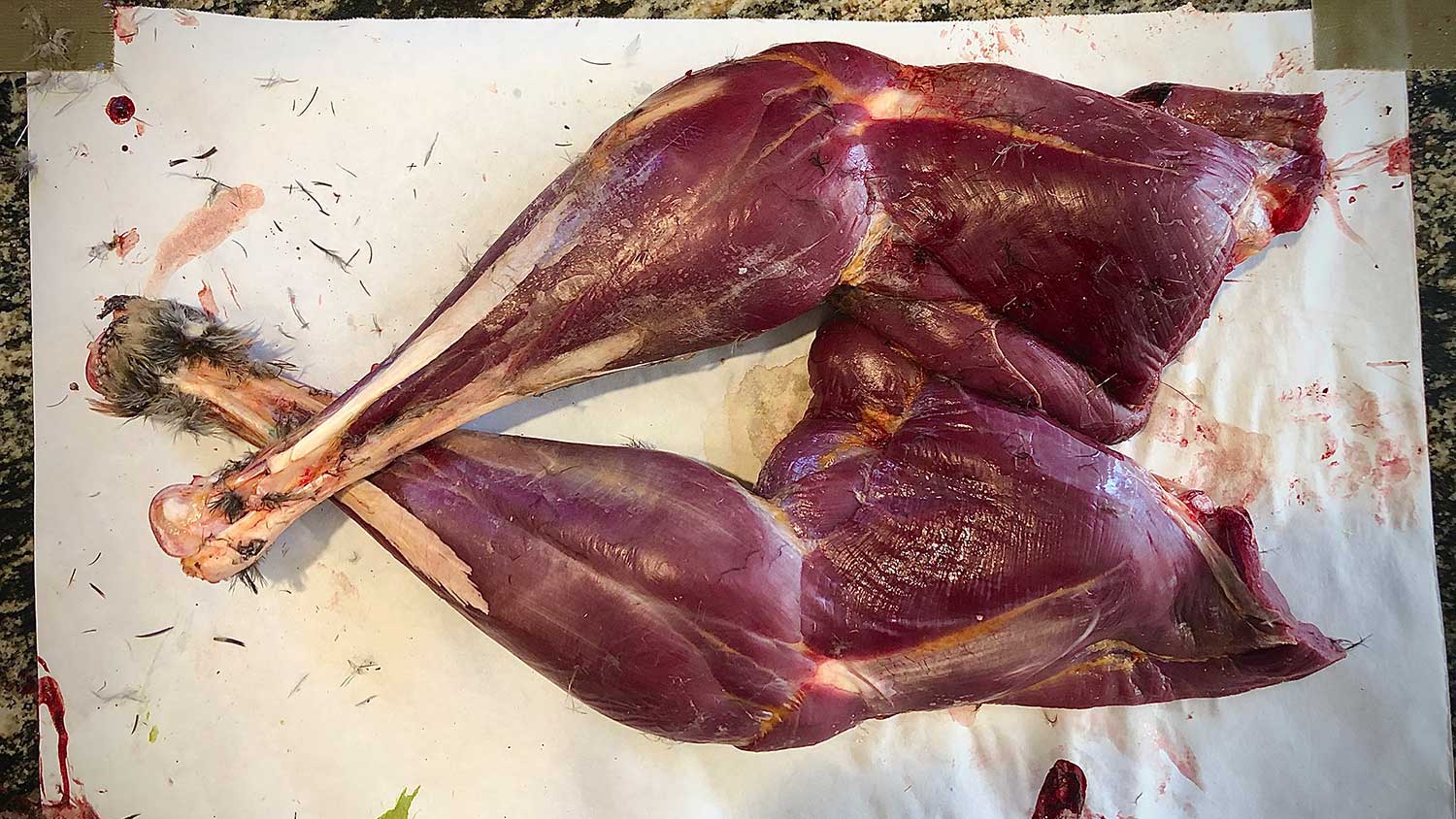
The leg meat on wild turkeys can be juicy, tender, and delicious, as long as you treat it right. Pulling them off your bird is pretty simple.
Separate the Drumstick from Thigh
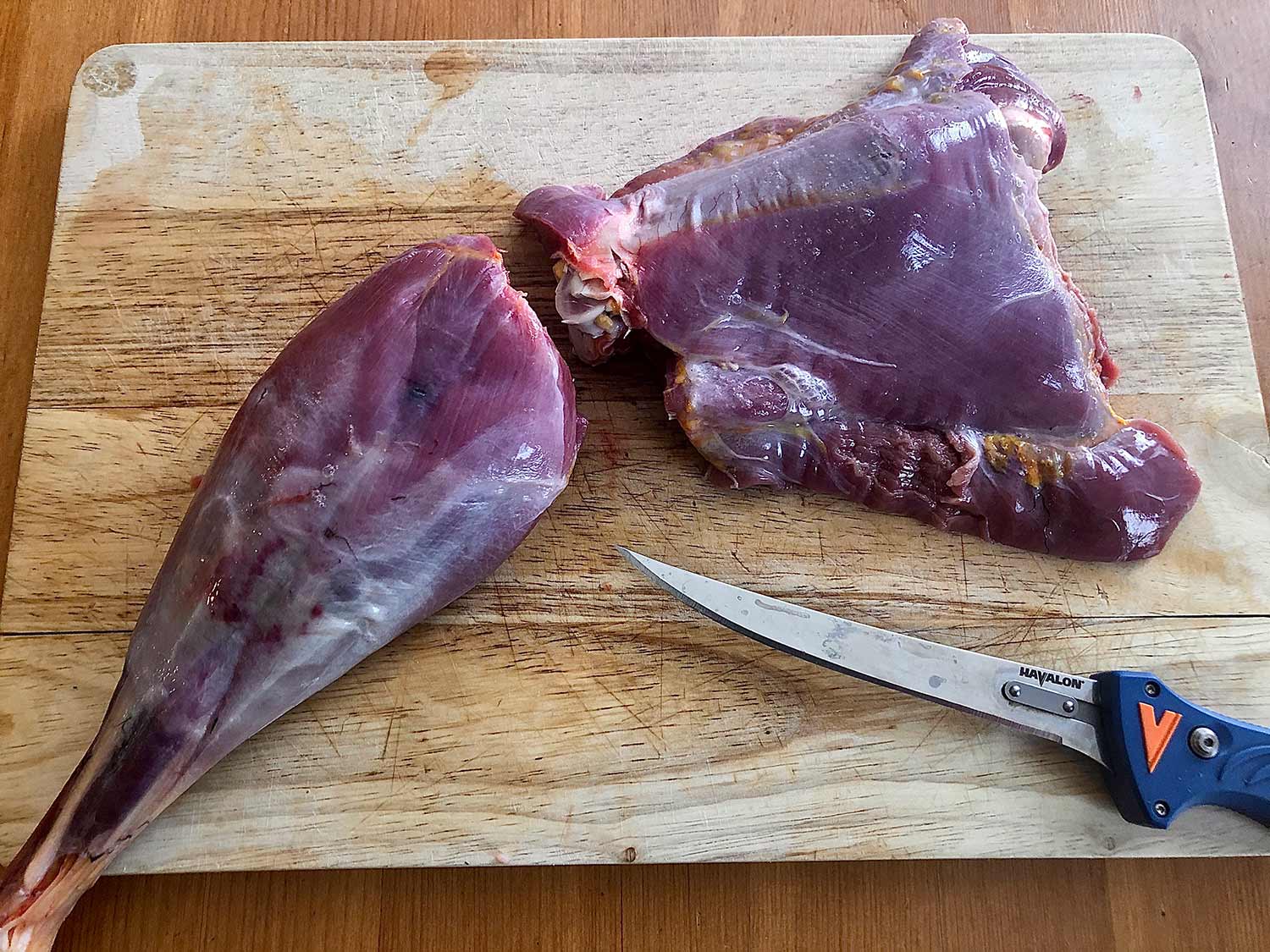
The key here is to separate the drumsticks from the thighs because they are anatomically different. The drumsticks have thick, heavy tendons running through them vertically, almost like the spokes of a bicycle wheel. No matter how you prepare the drumsticks, you won’t be able to cook down these tendons. So, you’ll need to shred the meat of the drumsticks. The thighs have tendons too, but they are not nearly as thick. If you slow cook the thighs, you can eliminate the chewiness of these tendons and wind up with delicious dark meat. The other benefit of splitting the thighs from the drumsticks is that two thighs or two drumsticks make a meal for two people (if you’ve got more to feed, you’ll just have to shoot more turkeys).
Separate the the drumstick from the thigh by cutting through the knee joint. First cut through the meat on the back of the joint, the line that separates the drumstick from the thigh will be obvious—just cut along that line. Then bend the drumstick backward and feel for the middle of the joint with the tip of your knife. When you find the soft spot in the joint, cut through it and the two pieces will come apart.
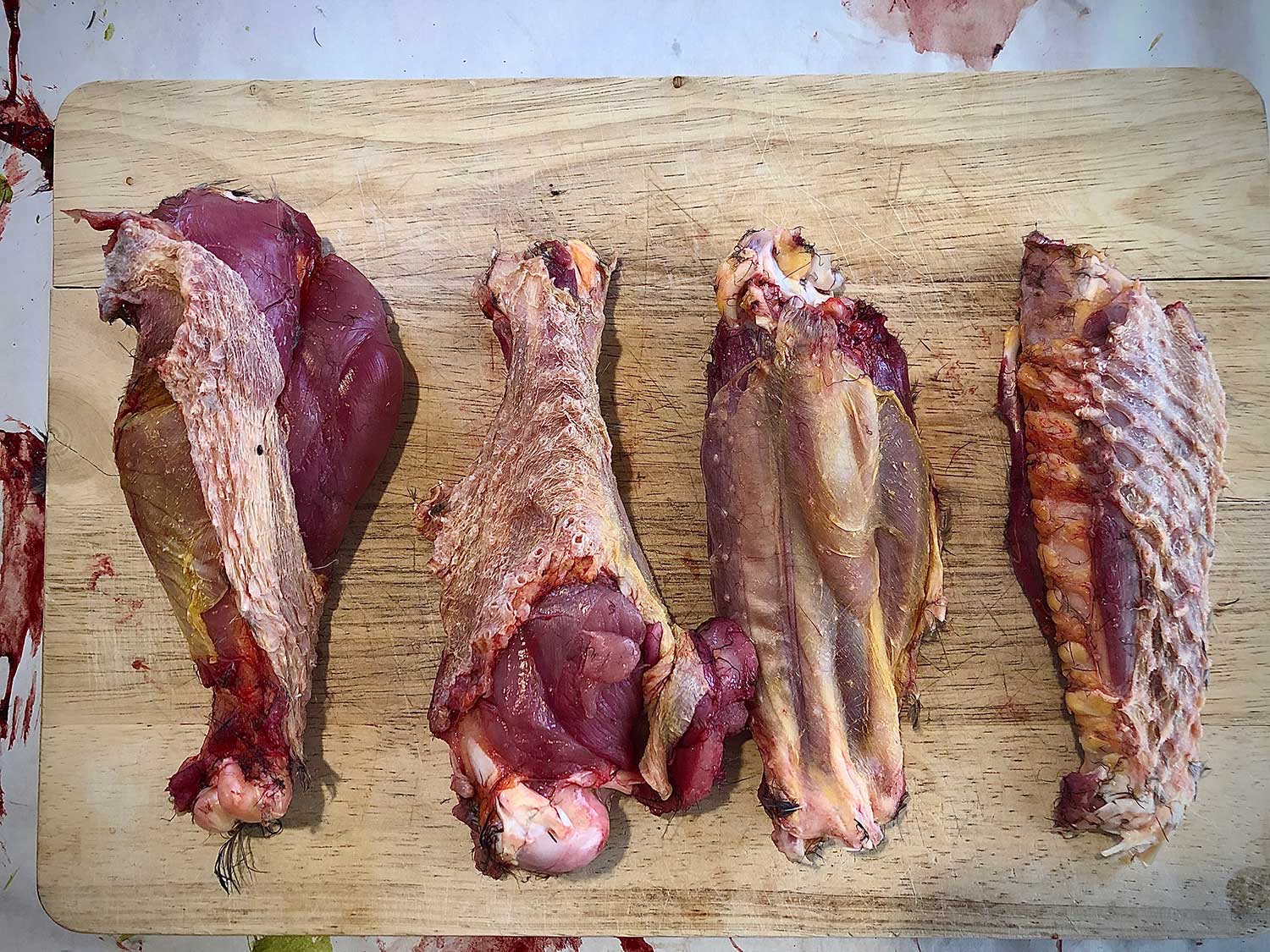
I’ll be honest: the wings take a good amount of work. After you’ve removed the breast meat, pop the wing joint by pushing it away from the body (similar to how you did with the thigh) and cut the wing off the body. Now, you can separate the two parts of the wing. Imagine the two types of the chicken wings you get at a bar—the drumette (which is shaped like a drumstick) and the flat or wingette (two little bones and meat in the middle). Separate these two sections by popping the joint and cutting through it and then get to plucking and skinning. Pluck off the small feathers and use your knife to cut away the big primary feathers. What you’ll end up with what looks like over-sized chicken wings, but unfortunately you can’t cook them like oversized chicken wings. Wild turkey wings are tough. I once tried to sous vide the wings for six hours and then fry them … and even then they were too tough to enjoy (though the flavor was great). My turkey hunting buddy Josh Dahlke has perfected a wild turkey buffalo wing recipe that’s definitely worth trying. There’s a surprising amount of meat on the wings, and they’re worth working on if you’ve got the time and determination.
Read Next: A Recipe for Wild Turkey Dumpling Soup
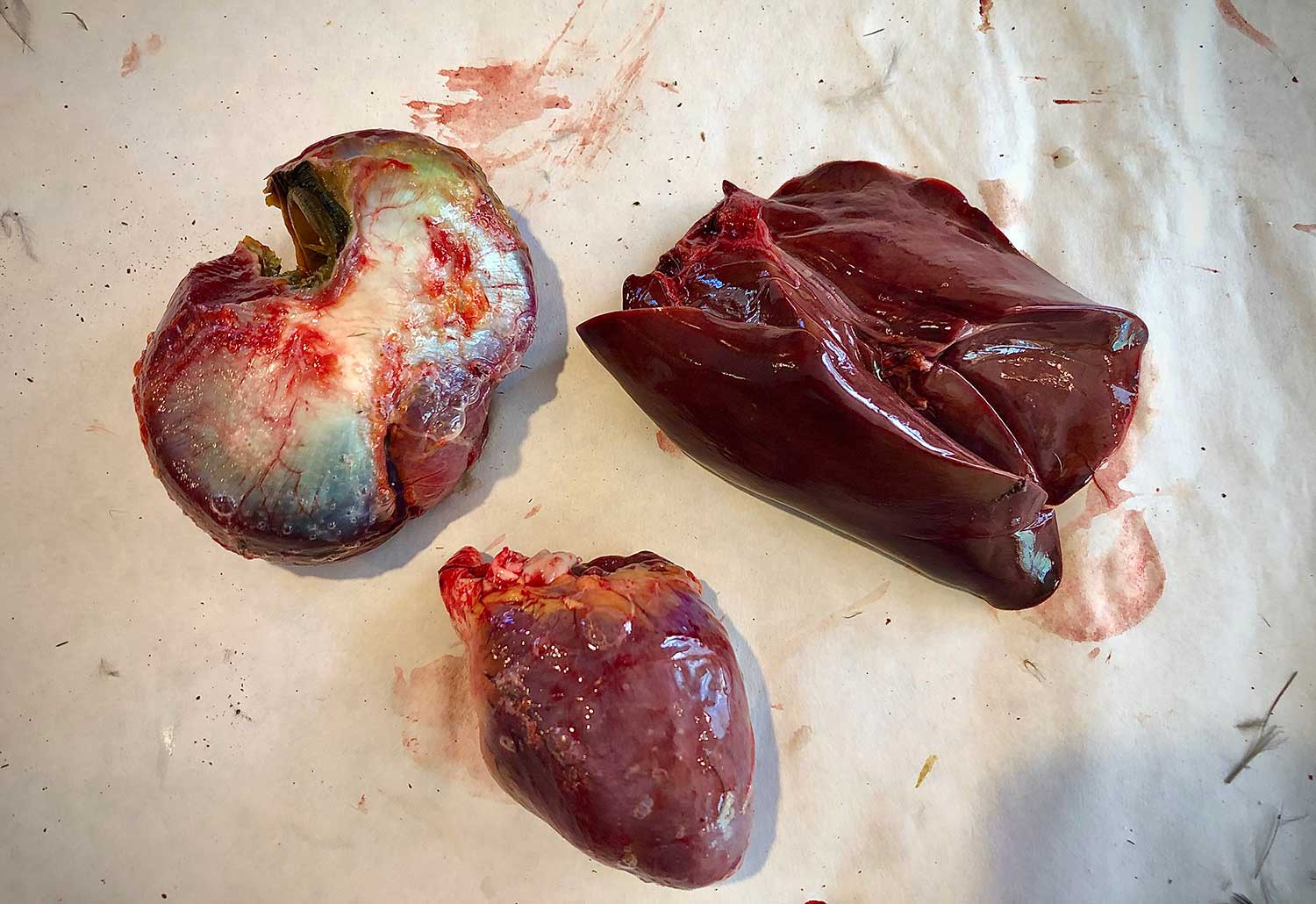
Now for the organs. I do this part last so I don’t get any guts on the other cuts of meat. Carefully slice into the bottom of the body cavity (below the breast bone) and then reach up and grab the gizzard, heart, and liver. The gizzard is a big, firm ball that’s full of pebbles or gravel (known as grit) and helps the turkey digest its food. This organ takes a little bit of prep work before its ready for the fryer. First, carefully slice open the gizzard and remove all the grit and the thick layer holding them. If you’ve seen the Netflix series Stranger Things, this layer kind of looks like the Demogorgan’s head. If you have no idea what the hell I’m talking about, it’s that super-tough liner inside the gizzard itself. Rinse the meat thoroughly and then peel away the gray inside tissue and the outside silver skin (using a sharp fillet knife). When I do this, I end up with two hunks of firm read meat. I’ll slice these into thinner chunks and also slice up the heart and liver and soak it all in milk overnight. Then I mix them in flour, cornmeal, seasoning, and fry them until they’re crispy. Serve with hot sauce. The heart and gizzard meat is very mild, with the gizzard having a little bit more chew to it, but in a good way. Both are delicious. The liver, well, it tastes like liver. Here’s a more in-depth look at how to remove and cook wild turkey giblets.
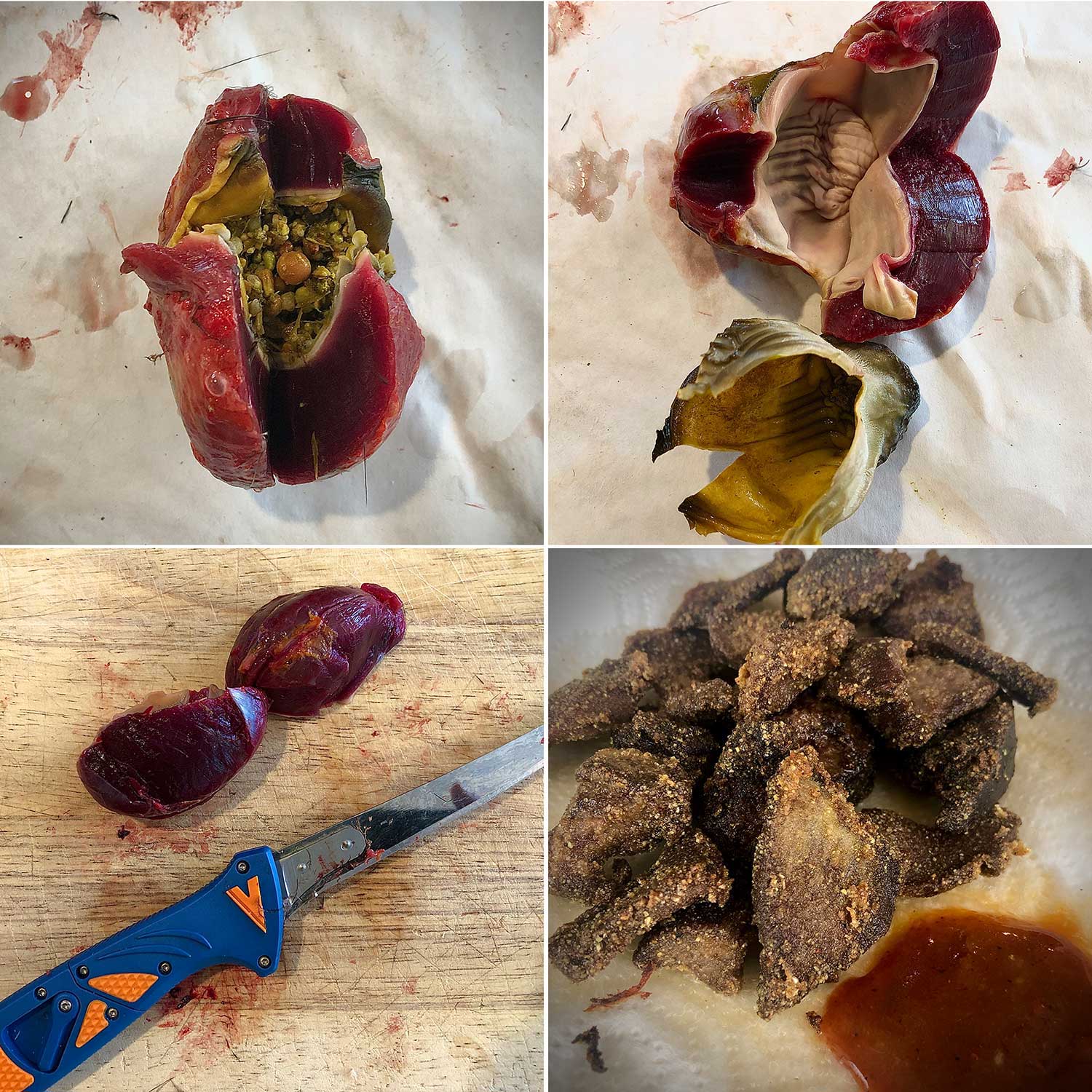
Trendy health and culinary people are all excited about bone broth these days. Well, bone broth is essentially the same thing as stock, and you can make it pretty easily with the bones from your wild turkey.
The big-ticket items here are the neck, which you can skin, and the keel bone (or sternum) which will be exposed after you remove the breast meat. You can also take the thigh bones, which are stout on big toms.
Stock is a key ingredient for soups and stews, and it’s pretty cool to use to use homemade stock for a wild turkey stew, all from the same bird. If you decide to cook the bird whole Thanksgiving-style, use the remaining carcass for soup. That truly utilizes every bit of meat including those two little ‘tenderloins’ on its backend.
READ NEXT: Best Vacuum Sealers
Your turkey hunt may be over, but this bounty of meat and bones will give you the chance to relive it again and again.
How to Clean a Turkey the EASY WAY!
FAQ
How do you slaughter a turkey?
How do they harvest turkeys?
Do you have to gut a turkey right away?
How to pick up a turkey?
How long does it take to harvest a Turkey?
16-20 weeks is the norm for harvesting broad-breasted domestic turkeys, with 18 weeks being the prime time. However, you can get away with 12 weeks, if you just want a 12-14 pound turkey. Heritage turkeys take 25-30 weeks to before they will be ready to be processed for eating.
What are the health benefits of ground turkey?
Ground turkey has multiple benefits. It is a good source of minerals, and B vitamins, rich in proteins, low in fat and it is lower in calories than common turkey.
How to raise turkeys on a farm?
To raise turkeys on your farm, you need to prepare their living space before the birds arrive. You should provide shelter, food, and water, heat lamps, bedding, and feeders. Turkeys need more space than chickens; the coop, the nesting boxes, the run are all bigger. A large pen or small barn works well for turkeys.
How long does it take to raise a Turkey?
Turkeys, taking approximately 16 to 22 weeks to reach desired market weight and very seasonal in demand, make a perfect spring or summer project. Depending on your climate and housing availability, they can also be raised year-round. When getting starting raising turkeys, take some time to note the resources you have available.
